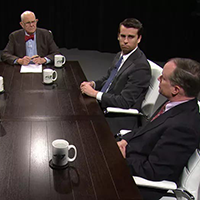A Look at North Carolina's Medicaid Program
Published April 9, 2013
By Lanier M. Cansler, former Secretary DHHS, as printed in the North Carolina Medical Journal
As North Carolina’s population grows, so too does the number of low-income residents who need the assistance of the state’s Medicaid program. Growing enrollment and the rising costs of health care delivery place the Medicaid program in the spotlight of state budget deliberations. Proposals set forth in the budget debate should take into account both the complexity of the Medicaid program and, perhaps more importantly, the critical role that Medicaid plays in providing health care for North Carolinians. Medicaid is not only the primary health care safety net for the poor; it is also a key factor in prevention and improved health for a major segment of the population, and it is a financially stabilizing factor for our health care delivery system, which provides care for all North Carolinians. This article provides insight into North Carolina’s Medicaid program, its importance, and its complexities. It demonstrates that controlling the Medicaid budget is not a simple task, and efforts to do so should take great care to protect both access and quality of care for the poor and the financial stability of North Carolina’s health care delivery system.
I have been monitoring the Medicaid policy and funding debate in North Carolina since 1997, when I became involved in the review and development of North Carolina’s Medicaid policy as cochair of the North Carolina House Appropriations Subcommittee on Health and Human Services. Doing so has given me a much better understanding of the programmatic, budgetary, and political complexities of that safety-net entitlement program for the state’s low-income citizens. And I have learned that there are many different views of North Carolina’s Medicaid program and the challenges it faces.
Many people depend on Medicaid for health care services for themselves or their children, some of them for a short time during a national economic downturn or a period of personal financial difficulties, and others for longer intervals, perhaps while receiving care in a skilled nursing facility during the final months or years of life. All of these individuals view Medicaid as a critical program that offers access to care that would not otherwise be affordable. They understand that without this program and its covered services, their primary source of health care would likely be the hospital emergency department rather than the office of a pediatrician or a primary care physician. Without Medicaid, it would likely be difficult or impossible for them to obtain access to such services as preventive care, care focused on the management of a chronic disease, or assistance when age or disability has left them unable to care for themselves.
For health care providers, particularly in low-income or rural areas of the state, Medicaid serves as the stabilizing financial factor that permits them to continue to provide health care services to the poorest of North Carolina’s residents—services that include primary care, specialty care, hospital care, skilled nursing and other long-term care, behavioral health care, and many other critical services covered under the program. Many providers of care, including community hospitals, skilled nursing and assisted living facilities, and others, would likely not survive financially without the money they receive from the Medicaid program. The survival of these providers is important not just to Medicaid consumers but also to the other North Carolinians who seek care from them.
Advocates of a healthier population see Medicaid as a program that provides health care and preventive care for those individuals who would otherwise be likely to face constant health challenges resulting from uncontrolled chronic disease, failure to obtain important vaccinations, and lack of simple, but critical, preventive screenings and treatments that result in both better health for the individual and lower costs within the health care delivery system.
Those who understand the economics of Medicaid and are aware that currently more than $8 billion in federal tax dollars are returned annually to the state of North Carolina through partial funding of the program by the federal government [1] see Medicaid as one of the state’s economic drivers, a program that creates jobs and sustains businesses while providing critical health care coverage for our low-income population. The Kaiser Family Foundation reports that in 2011, more than 10% of North Carolina’s jobs were related to health care [2]. The North Carolina Office of Rural Health and Community Care notes that the health care industry is among the top 5 employers in 64 of the state’s 100 counties [3]. And according to an article on the EconPost Web site, in 2008 health care was the fifth largest growth segment of North Carolina’s economy [4]. Medicaid constituted approximately 18% of health care spending in the state in 2009 [5].
But in recent years, North Carolina’s Medicaid program has come to be viewed by many in state government as a growing budget problem that must be controlled, rather than as a critical safety net, a stabilizing financial factor in our health care delivery system, a key component in prevention and improved health, or an economic driver that plays a role in our state’s economy. We may share their concern about the long-term financial sustainability of the Medicaid program and our health care delivery system in general, but the control of Medicaid costs, and the approach to achieving that control, should maintain a focus on achieving the policy goals of the program, protecting the safety net, and maintaining the financial stability of our health care delivery system. To fail in any of these policy goals will likely ultimately result in even greater costs to North Carolina.
Understanding North Carolina’s Medicaid Program
To effectively participate in the debate over Medicaid policy and the Medicaid budget, it is important to understand how North Carolina’s Medicaid program operates. Undoubtedly, the existence of the Medicaid program has provided substantial benefit to the residents of the state over the years.
Title XIX of the Social Security Act became law in 1965 and created the Medicaid program as a cooperative venture jointly funded by the federal government and state governments to assist states in furnishing medical assistance to eligible needy persons. Within constraints imposed by the federal government, states are able to set their own eligibility standards for coverage; establish the type, amount, duration, and scope of services; and determine what the payments will be for the providers of those services. In 1969, the North Carolina General Assembly approved the creation of a medical assistance program, and the state submitted a Medicaid plan to the federal government [6]. The plan was approved, and it began operations on January 1, 1970. Initially the program was under the direction of the North Carolina Division of Social Services. In 1978, as the program continued to grow in size and complexity, management of Medicaid was transferred to the newly created Division of Medical Assistance (DMA) within what was then known as the Department of Human Resources. By 1978, the state’s Medicaid program covered approximately 456,000 low-income North Carolinians at an annual cost of approximately $307 million [6]. According to the Kaiser Family Foundation, in fiscal year (FY) 2009 North Carolina’s Medicaid program provided coverage to more than 1.8 million individuals sometime during the year [7]. The total program cost was approximately $10.9 billion in FY 2010 [8].
North Carolina’s Medicaid budget is large and continues to grow with demand, but the federal government shares in both the cost of the services provided and administrative costs. The level of federal financial participation is referred to as the Federal Medical Assistance Percentage (FMAP). FMAP is established annually and varies by state, because the rate for each state is based on its per-capita income. The minimum FMAP is 50% for covered services. North Carolina’s FMAP for FY 2013 has been set at 65.51% [9]. However, certain services receive a higher FMAP. For example, federal funds pay 90% of the costs of family planning services and 100% of the costs of services provided through Indian tribal facilities (such as the Health and Medical Division of the Eastern Band of Cherokee Indians) [10]. Normally the federal government pays 50% of administrative costs, but in some cases it pays a higher percentage of those costs. For instance, the federal government pays 100% of the costs to verify immigration status; 90% of the costs to verify citizenship; 90% of the costs to design, develop, and install Medicaid Management Information Systems (MMIS); and 75% of the ongoing costs of managing and operating such systems [10]. States that choose to expand Medicaid under the Patient Protection and Affordable Care Act of 2010 will receive a FMAP of 100% for the first 3 years to pay for services for newly eligible enrollees. The FMAP would then begin to decline, stabilizing at 90% in 2020 [11].
To receive coverage under the Medicaid program, an individual must currently generally meet 4 eligibility criteria. First, the person must be a US citizen, or an immigrant who has been lawfully present in the United States for at least 5 years. Second, the individual must meet “categorical” eligibility requirements: He or she must be a child under the age of 21 years, a pregnant woman, the parent of a child under the age of 19 years, an adult 65 years of age or older, or an individual with a disability who meets the Social Security disability standards [12]. Single, childless, nondisabled, and nonelderly adults do not generally qualify for Medicaid. Approximately 500,000 low-income adults would be eligible for Medicaid if North Carolina chose to expand Medicaid. Expanding coverage to this group would actually result in net savings to the state of $65 million during the first 8 years the expansion was in effect [13].
Third, the individual’s income must be lower than the income thresholds established by the state. These thresholds vary among the eligibility categories. For children under the age of 21 years, coverage is available to those with countable household incomes of up to 200% of the federal poverty guidelines (often referred to as the federal poverty level, or FPL). For FY 2013, that 200% figure is $47,100 for a family of 4, and $22,980 for an individual [14]. It should be noted that children younger than 19 years of age may, depending on their age and income, qualify either for Medicaid coverage or for coverage under North Carolina’s Child Health Insurance Program (CHIP), which is known as Health Choice. The parents of children under the age of 19 years can qualify for Medicaid coverage only if their countable income is less than approximately 50% of the FPL if they are working (for 2013, that figure is $11,775 for a family of 4, or $5,745 for an individual) or less than about one-third of the FPL if they are not working. For individuals in the aged and disabled eligibility category, coverage is available if countable income is below 100% of the FPL (for 2013, that figure is $11,490 for an individual, or $15,510 for a family of 2) [14].
Finally, the Medicaid program considers the individual’s resources, including money in the bank and other financial holdings. Again, the resource limits vary among the eligibility categories. Children and pregnant women do not have resource limits, because it is recognized that most families with young children living in poverty do not have sufficient resources to meet ongoing health needs. Older adults or people with disabilities cannot have more than $2,000 in countable resources. The limit is $3,000 for a couple [12].
Over the 42 years that the Medicaid program has operated in North Carolina, eligibility standards and covered services have been modified and expanded numerous times, taking into account overall changes in health and health care delivery as well as the changing needs of the people of the state [6]. In some cases, changes have resulted from increased federal requirements. Because Medicaid is a collaborative effort between the federal government and state governments, and because the federal government provides a substantial portion of the funding for the program, any change in the program that the state legislature wants to make generally requires approval by the federal government. Examples of changes that have been made over the years include the following: the implementation in 1983 of what is now known as the Community Alternatives Program for Persons with Intellectual and Developmental Disabilities (CAP/IDD); legislative approval in 1984 for funding of services for pregnant women and children; the inclusion of coverage for hospice services beginning in 1988; the implementation in 1991 of the demonstration project for the Carolina ACCESS program, a managed care program; the expansion of available health care coverage for children when the legislature approved the creation of Health Choice in 1998; and in 1999, the expansion of Medicaid coverage eligibility for those in the aged and disabled category with incomes up to 100% of the FPL [6].
Covered services under North Carolina’s Medicaid program include both the mandatory services that are required to be covered by the federal government and optional services that have been approved by the state legislature over the program’s history. In general, states are mandated to provide coverage for physician services; hospital inpatient and outpatient services; laboratory and x-ray services; early and periodic screening, diagnosis, and treatment services for children under 21 years of age; family planning services and supplies; nursing facility services for adults age 21 years and older; home health care; and transportation services. Medicaid must also provide coverage for services provided by federally qualified health centers (such as community health centers), rural health clinics, pediatric and family nurse practitioners, and nurse midwives.
Optional services covered in North Carolina include such services as prescription drugs, behavioral health and substance abuse services, dental services, vision care, therapy services, intermediate care facilities for persons with intellectual and developmental disabilities, personal care services, hospice care, prosthetic devices, and durable medical equipment.
The Medicaid Budget
Almost every state in the country is engaged in efforts to better control its Medicaid budget. Many of the current Medicaid cost-reduction efforts by governors and legislatures across the country have been driven by the major economic recession and slow recovery that we have experienced over the past 4 years. Medicaid program enrollment and utilization of services grow more rapidly in poor economic times. Unfortunately, when the economy is doing poorly, state government revenues decline. Medicaid costs continue to consume large amounts of state budgets, and the program competes with education and other services for funds.
North Carolina is no exception. Our state government spends an extraordinary amount of time and effort attempting to control the cost of Medicaid as well as the costs of Health Choice and of the North Carolina State Health Plan for employees. Some of these efforts have included reducing provider reimbursement rates, limiting utilization of certain services by capping utilization or by implementing prior authorization requirements, redefining services or provider requirements, and eliminating access to certain services entirely. Although many of these efforts may have a favorable impact on the budget, that favorable impact is often short-lived, for many such efforts simply shift costs from one area to another with no actual overall benefit. Within North Carolina’s health care delivery system, major reductions in Medicaid coverage and funding may simply result in costs shifting to the private and commercial sectors.
In recent decades North Carolina has been one of the fastest-growing states in the country. With a rapidly growing population, the low-income population has grown as well, steadily increasing the number of individuals who are financially eligible for the Medicaid program. According to DMA, in 1999-2000 more than 1.22 million individuals were covered under North Carolina’s Medicaid program [6]. By 2009, that number had grown to more than 1.81 million individuals, an increase of approximately 50% [7]. Although some of that increase was the result of the legislature’s expansion of the program for those in the aged and disabled eligibility category, much of the increase resulted from the state’s population growth and the decrease in personal income levels during poor economic times. From 1999 to 2009, North Carolina’s population grew from an estimated 7.949 million people to 9.435 million, an increase of nearly 1.5 million, or about 19% [15].
Another issue related to program budget growth is that North Carolina’s population is also aging rapidly, and the older our population, the higher our health care costs will be. The North Carolina Division of Aging and Adult Services reports that people 65 years of age or older made up 13.3% of the state’s population in 2011 but will constitute 19.6% of the state’s population in 2031 [16]. By 2025, 1 in 4 North Carolinians will be 60 years of age or older, and 86 of North Carolina’s 100 counties will have more people 60 years of age or older than people under the age of 18 years [17]. This growing population of older adults will have a substantial impact on the cost of Medicaid’s long-term care services in coming years. The Kaiser Family Foundation reports that in FY 2010, approximately 29.1% of North Carolina’s Medicaid expenditures were for long-term care [18]. Although most individuals 65 years of age or older are covered by the national Medicare program, Medicare offers only limited coverage for long-term care costs. Berry and Woody talk about the role of Medicaid in addressing the needs of older adults in their commentary in this issue [19].
Kaiser Family Foundation data for FY 2009 show that approximately 27% of those enrolled in the North Carolina Medicaid program were categorized as aged or disabled [20], and that the cost of services for those 2 categories of recipients made up approximately 63% of the program’s total costs that year [21]. With a rapidly aging and growing population that can be expected to include an increasing number of individuals with disabilities, Medicaid enrollment of this more expensive population will continue to grow. The reality of an aging coverage group confronts not just the Medicaid program, but also the North Carolina State Health Plan for employees, which has no federal financial participation.
Another consideration in the assessment of Medicaid budget growth is the cost of health care innovations, including new technology, new drugs, new procedures, and new ways to diagnose and treat health issues. The enhancement of our health care delivery system often results in new costs and demands within the system. This also plays a role in the growth of the Medicaid budget.
Finally, growth in the Medicaid budget has occasionally been driven by legislative decisions to supplement state-funded programs with federal dollars through expansion of services offered under the Medicaid program. For example, in the late 1990s, the North Carolina General Assembly expanded Medicaid to provide coverage of personal care services in adult care homes. The Medicaid funding, with the federal match, provided some relief of budgetary pressures on the state and counties in State/County Special Assistance (SA) funding. Prior to this expansion, the SA funding was the primary source of funding for assisted living care. So although the Medicaid program has grown, that growth may have provided some relief in other areas of the state’s budget. This fact is often overlooked in the Medicaid budget debate.
Identifying Solutions
When debating the Medicaid budget, it is easy to point fingers at program management and to express concerns about this growing part of the state’s overall budget. However, once the issues surrounding Medicaid budget growth are carefully analyzed, it becomes obvious that enrollment growth and overall trends in health care delivery have had the greatest impact on the cost of the program. While reimbursement for Medicaid services are higher for some of North Carolina’s provider community than in some other states, Medicaid remains near the bottom of reimbursement rates compared to all other payers for service including the national Medicare program. Many would argue that the low Medicaid and Medicare reimbursement rates have had the impact within the health care delivery system of shifting costs to private and commercial payers and thus increasing the cost of insurance premiums for individuals and employers.
Even though North Carolina’s Medicaid expenditures have continued to grow, program management succeeded in limiting program growth to approximately 3.5% during the period from 2007 to 2010, when the national growth rate in Medicaid spending was 6.8%, almost twice that of North Carolina [22]. The program has worked to control growth through such initiatives as the implementation of prior authorization on certain high-cost and overutilized services, adjusting provider rates when determined appropriate, enhanced care management focused on prevention and chronic disease, and adoption of technology to enhance the ability to identify improper utilization and fraudulent activities. While a recent report by the State Auditor raises issues about administrative costs, over 50% of the costs in that report were costs incurred by the state’s 100 counties in meeting their responsibilities with respect to Medicaid management, and by the Local Management Entities in their administrative oversight of the state’s mental health care delivery system. Central management in the Division of Medical Assistance and the necessary work performed in other DHHS divisions related to Medicaid management make up only about 3.2% of Medicaid program costs (Division of Medical Assistance, unpublished data, 2013). Because of federal participation in these costs, any cost allocation plans are approved by CMS.
The Medicaid budget cannot be controlled simply by making artificial adjustments to funding or eliminating covered services, because changes that on the surface appear to reduce costs often in reality result in cost shifting, with no net gain. Although Medicaid is, in fact, a large insurance operation, unlike other insurers the program does not have a reserve fund to cover ups and downs in the volume of medical claims. If claims unexpectedly go up, the increase may be inaccurately viewed by some as a budget problem resulting from management failure.
In reality, there are 4 ways to control or perhaps even reduce the Medicaid budget. The first is to reduce enrollment by eliminating or tightening the requirements for some categories of eligibility. Because the federal government does not allow states to “grandfather” coverage for individuals already receiving Medicaid under existing eligibility rules, making a change of this sort results in services being taken away from individuals who currently have access to them. Even if state officials are willing to accept the political consequences of taking such an action, the Affordable Care Act limits the states’ ability to make these types of eligibility decisions [23].
The second way to control the Medicaid budget is to eliminate or reduce coverage for certain services. This is not an option with respect to mandatory services or the necessary services for children. The major services under the optional services classification would be pharmacy services (prescription drugs), behavioral health and substance abuse services, and personal care services for those receiving in-home or assisted living care. The cost of these services constitutes over 80% of the cost of all optional services offered under North Carolina’s Medicaid program [24]. Although the legislature has modified some optional services over the past several years, the cost shifting that would follow the elimination or even the substantial reduction of any major optional service means that it is likely that there would be no aggregate savings and, in some cases, such as the elimination of pharmacy services, a substantial increase in costs on the mandatory services side of the program might be the result.
The third way to control costs is to reduce reimbursement rates for the provision of health care services. As mentioned earlier, North Carolina Medicaid is already paying one of the lowest rates of any payer to health care providers for their services. In the late 1990s, the legislature approved an increase in physician rates to encourage physicians to serve Medicaid patients [6]. That effort by the legislature had a significant impact on access to care for the state’s low-income individuals, with perhaps the greatest impact on access for children. Each implemented reduction in Medicaid reimbursement rates has the potential to reduce access to care in physicians’ offices. If access to primary care is impacted, the alternative again becomes increased utilization of hospital emergency departments for nonemergency care, along with decreases in preventive care and chronic disease management. The concern about negatively impacting access to care has resulted in the federal government requiring a study of impact on access to care whenever a state submits Medicaid plan amendments that reduce provider reimbursement rates. If access to care is an issue, approval of plan amendments to reduce reimbursement rates may be denied.
The fourth way to control Medicaid costs is to ensure that utilization of services is appropriate and follows best practices related to the diagnosis and treatment of health issues. This is partly a matter of program integrity, which is a major responsibility of DMA. They must ensure that the billing for services is appropriate and has been submitted by qualified providers, and that the actual delivery and utilization of services was appropriate and effective for the health issues of the individual Medicaid consumer. Over the past several years, North Carolina’s Medicaid program has expanded its technological capabilities to identify possible system abuse and overutilization or improper utilization of services by providers and consumers. But even after abuses or improprieties have been identified and confirmed, existing processes and legal maneuvers on the part of providers can make it challenging to recoup money paid for inappropriate or unnecessary services. However, abusive providers lose their ability to continue to bill Medicaid inappropriately, thus reducing subsequent program costs.
Although efforts to ensure program integrity are important, North Carolina has learned that management of care provides the greatest benefit with respect to appropriate utilization. Effective care management is the preferred approach to controlling costs as it controls costs by improving health while avoiding utilization of services that are not appropriate or necessary. The creation and continued development of Community Care of North Carolina (CCNC) has been the state’s centerpiece in the development of medical homes and coordination of care under the Medicaid program. The approach to care management initiated by CCNC has been duplicated in numerous states and is often referred to as the gold standard. CCNC initially focused on access to care through the creation of a primary care medical home and the management of chronic diseases such as diabetes and asthma. But over the years CCNC has developed the capability of improving health outcomes while controlling costs through appropriate management of care. CCNC understands the state’s goals in Medicaid program management and continues to evolve into an organization capable of achieving both access and quality of care while controlling costs.
Additional information about CCNC may be found in the commentary in this issue by Dobson, Levis, and Wade [25]. The commentary by Seligson and Pully illustrates how CCNC has made a difference by improving health outcomes and reducing unnecessary expenditures for children with asthma [26]. And Somers, Martin, and Hendricks discuss how North Carolina’s approach to managing the care of Medicaid recipients compares with that of other states [27].
DMA has succeeded in managing a constantly growing Medicaid program with a limited staff and a tight administrative budget. The program’s direct central administrative costs make up approximately 3.2% of total costs, a proportion that is substantially less than that of the reported administrative costs of any large insurance company or managed care organization. As mentioned earlier, the average annual increase in North Carolina’s overall Medicaid budget from 2007 to 2010 was 3.5%. This compares very favorably to Medicaid growth rates in other Southeastern states: Virginia had a Medicaid growth rate during that period of 9.2%; Louisiana, 9.0%; Florida, 8.6%; Arkansas, 8.4%; South Carolina, 7.5%; Kentucky, 6.9%; Tennessee, 6.1%; West Virginia, 5.5%; Alabama, 4.9%; and Georgia, 3.6%. Nationally, the average annual growth rate was 6.8% [22]. North Carolina’s per-capita growth rate was even lower. The average annual per-capita growth rate in North Carolina’s Medicaid program from 2006 to 2009 (the latest year data are available) was 2.2%. This compares to 4.2% in the Southeast and 3.1% nationally. North Carolina’s per-capita annual increase in Medicaid expenditures was also lower than the state’s overall per-capita increase in health care expenditures during the same period (2.2% vs 3.2%) [28].
The size of the Medicaid budget is a reflection of the larger problem of the cost of our national health care delivery system. The approach North Carolina has taken—improving the quality and effectiveness of care through building a strong care management network—has demonstrated to the nation the importance of care management in avoiding unnecessary care and controlling inappropriate utilization of services, thereby controlling growth in costs. This has been accomplished with minimum administrative costs, allowing available funding to be totally focused on the delivery of care.
Acknowledgment?Potential conflicts of interest L.M.C. serves as an advisor to a number of health care organizations.
References
1. Kaiser Family Foundation. North Carolina: Medicaid spending. Statehealthfacts.org Web site. http://www.statehealthfacts.org/profileind.jsp?cat=4&sub=47&rgn=35&cmprgn=1. Accessed February 12, 2013.
2. Kaiser Family Foundation. North Carolina: Health care employment. Statehealthfacts.org Web site. http://www.statehealthfacts.org/profileind.jsp?cat=8&sub=105&rgn=35. Accessed January 22, 2013.
3. Health care and North Carolina’s economy. North Carolina Office of Rural Health and Community Care Web site. http://www.ncdhhs.gov/orhcc/data/01opening_text.pdf. Accessed January 24, 2013.
4. EconPost. North Carolina GDP size and rank. EconPost Web site. http://econpost.com/northcarolinaeconomy/north-carolina-gdp-size-rank. Accessed February 12, 2013.
5. Centers for Medicare and Medicaid Services. Health expenditures by state of residence (US aggregate, Medicaid aggregate). http://www.cms.gov/NationalHealthExpendData/downloads/resident-state-estimates.zip. Accessed February 13, 2013.
6. Division of Medical Assistance (DMA), North Carolina Department of Health and Human Services. History of the North Carolina Medicaid Program: State Fiscal Years 1970 to 2007. DMA Web site. http://www.ncdhhs.gov/dma/pub/historyofmedicaid.pdf. Accessed January 22, 2013.
7. Kaiser Family Foundation. Total Medicaid enrollment, FY 2009. Statehealthfacts.org Web site. http://www.statehealthfacts.org/comparemaptable.jsp?ind=198&cat=4. Accessed January 22, 2013.
8. Kaiser Family Foundation. Total Medicaid spending, FY 2010. Statehealthfacts.org Web site. http://www.statehealthfacts.org/comparemaptable.jsp?ind=177&cat=4. Accessed January 22, 2013.
9. Federal financial participation in state assistance expenditures; federal matching shares for Medicaid, the Children’s Health Insurance Program, and Aid to Needy Aged, Blind, or Disabled Persons for October 1, 2012, through September 30, 2013. Fed Regist. 2011;76(230):74061-74063.
10. Kaiser Commission on Medicaid and the Uninsured. Medicaid Financing: An Overview of the Federal Medicaid Matching Rate (FMAP). September 2012. http://www.kff.org/medicaid/upload/8352.pdf. Accessed January 22, 2013.
11. 42 USC §1396d(y) (2010).
12. Medicaid eligibility. North Carolina Division of Medical Assistance Web site. http://www.ncdhhs.gov/dma/medicaid/medicaideligchart.pdf. Accessed January 24, 2013.
13. North Carolina Institute of Medicine. Examining the Impact of the Patient Protection and Affordable Care Act in North Carolina (2013). Appendix C: Medicaid Cost Estimates. Revised February 12, 2013. http://www.nciom.org/wp-content/uploads/2013/01/final-Medicaid-cost-estimates-FINAL-2.12.2013.pdf. Accessed February 19, 2013.
14. 2013 Poverty Guidelines. US Department of Health and Human Services, Assistant Secretary for Planning and Evaluation Web site. http://aspe.hhs.gov/poverty/13poverty.cfm. Accessed February 21, 2013.
15. Annual North Carolina population growth. Office of State Budget and Management Web site. http://www.osbm.state.nc.us/ncosbm/facts_and_figures/socioeconomic_data/population_estimates/demog/ncpopgr11.html. Accessed January 24, 2013.
16. Aging statistics in North Carolina. North Carolina Division of Aging and Adult Services Web site. http://www.ncdhhs.gov/aging/cprofile/NC-AgingStatistics.pdf. Accessed January 24, 2013.
17. North Carolina is aging! North Carolina Division of Aging and Adult Services Web site. http://www.ncdhhs.gov/aging/NC_is_aging.pdf. Accessed January 24, 2013.
18. Kaiser Family Foundation. Distribution of Medicaid spending by service, FY 2010. Statehealthfacts.org Web site. http://www.statehealthfacts.org/comparetable.jsp?ind=178&cat=4. Accessed January 22, 2013.
19. Berry KD, Woody GS. Community based services: stopgap for runaway Medicaid costs. N C Med J. 2013;74(suppl):S21-S24.
20. Kaiser Family Foundation. Distribution of Medicaid enrollees by enrollment group, FY2009: aged. Statehealthfacts.org Web site. http://www.statehealthfacts.org/comparemaptable.jsp?ind=200&cat=4. Accessed January 22, 2013.
21. Kaiser Family Foundation. Distribution of Medicaid payments by enrollment group, FY2009: aged. Statehealthfacts.org Web site. http://www.statehealthfacts.org/comparemaptable.jsp?ind=858&cat=4. Accessed January 22, 2013.
22. Kaiser Family Foundation. Average annual growth in Medicaid spending, FY1990-FY2010. Statehealthfacts.org Web site. http://www.statehealthfacts.org/comparetable.jsp?ind=181&cat=4. Accessed January 22, 2013.
23. 42 USC §1396a(a)(74), 1396a(gg) (2010).
24. Willoughby M. Optional services take up half of NC Medicaid budget. Civitas Institute. Watchdog.org Web site. http://watchdog.org/15370/optional-services-take-up-half-of-nc-medicaid-budget/. Published May 4, 2012. Accessed February 13, 2013.
25. Dobson LA, Hewson DL, Wade TL. Community Care of North Carolina in 2013. N C Med J. 2013;74(suppl):S12-S15.
26. Pully WA, Seligson RW. Nikki’s story shows the success of Community Care of North Carolina. N C Med J. 2013;74(suppl):S19-S20.
27. Somers S, Martin L, Hendricks T. Community Care of North Carolina: an evolutionary platform for Medicaid innovation. N C Med J. 2013;74(suppl):S16-S18.
28. Centers for Medicare and Medicaid Services. Health expenditures by state of residence (Medicaid per enrollee, US per capita). http://www.cms.gov/NationalHealthExpendData/downloads/resident-state-estimates.zip. Accessed February 13, 2013.
April 11, 2013 at 1:22 pm
dj anderson says:
Thank you for this fine article. It's the best yet on this on this topic on this forum. I do have comments.
One could reasonably ask the article to also provide insight into the proper amount the taxpayer should pay for medicaid services. There is always more that could be spent, and there is the inclination to spend as little as possible, but somewhere between the two extremes there is a proper balance between two.
As said in the first sentence, the Medicaid budget is to be controlled, and with Medicaid as is, taking 17% of our state budget, and projected to take over 50% of state budgets in 17 years, the cost could be viewed as a 'problem' as money is taken from Education's current 50% share, or from increased taxes, or somewhere. Spending on Medicaid is an increasing burden for the tax payer to bear. Expenditures are increasing faster than revenues, and that is a problem. The article recognizes these conflicts.
"Advocates of a healthier population..." 5th paragraph opening
As opposed to those wanting less healthy people? Who are they? Does that non-advocate group include doctors who don't accept medicaid patients or that won't treat patients in their offices who can't pay, or the pharmacies that won't fill Rx's without payment? Name names. I'm assuming the bad guys are always those with differing views unless named.
"When debating the Medicaid budget, it is easy to point fingers at program management..." 1st sentence under Identifying solutions
Instead of viewing any review of medicaid as an attack on it, I would say the best defense of medicaid would be every insistence that it be granted and administered fairly, effectively, and efficiently. Show the public a dollar of tax well spent and another penny can be asked. Show the public a penny misspent, and the next dollar is in doubt.
My comment is growing too long to read, and none to Tom C's blog ever get posted, so I'll conclude, saying this:
I want every wound tended, every disease treated, all suffering minimized, every disabled person fed, housed & attended as needed. All at dispute here are weeding out the fakers, takers and pandering. They are the thieves stealing from the poor souls among us by robbing the the public of its confidence.
May 31, 2013 at 9:25 pm
Managed Care and Partnership for a Healthy North Carolina | Autism Society of North Carolina Blog says:







